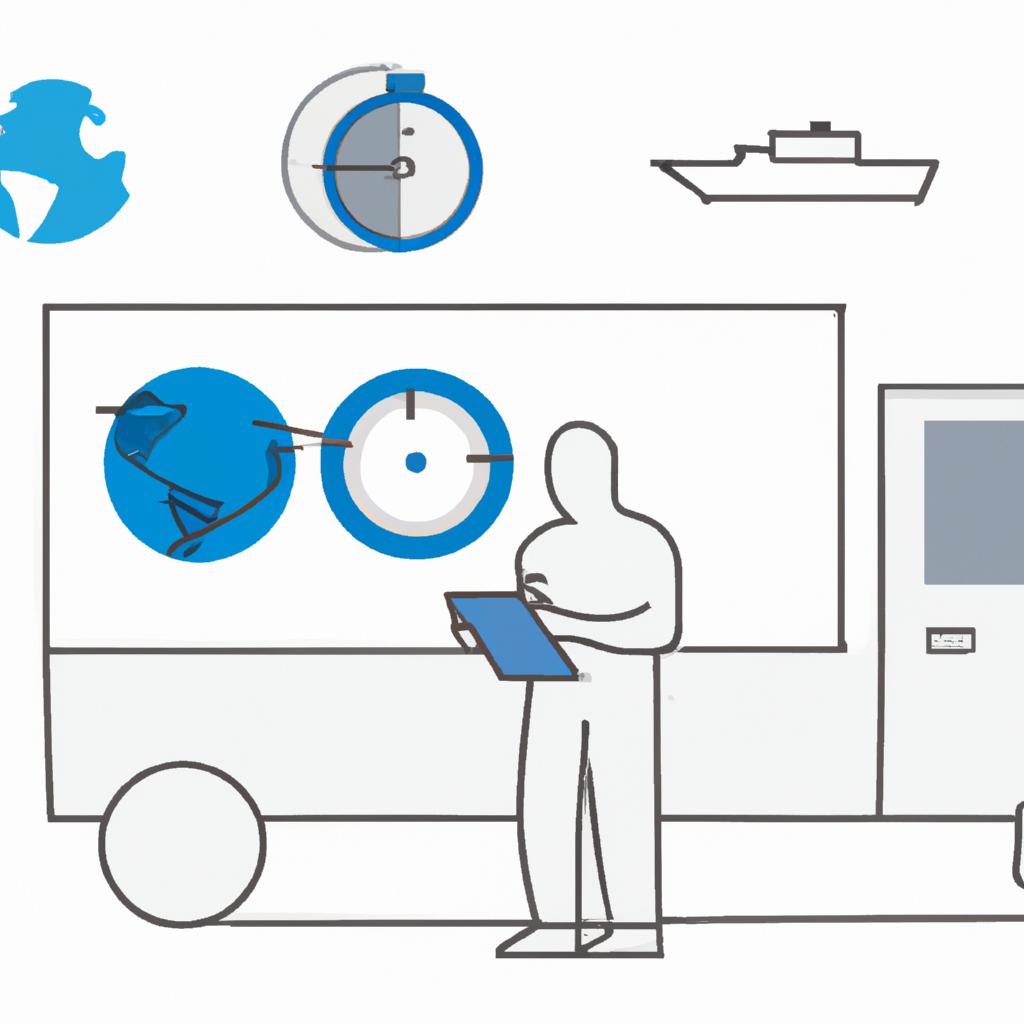Route Optimization: Enhancing Supply Chain Efficiency in Transportation and Logistics


Route optimization plays a crucial role in enhancing supply chain efficiency within the transportation and logistics industry. By strategically planning and optimizing routes, companies can minimize costs, improve delivery times, reduce fuel consumption, and ultimately enhance customer satisfaction. For instance, consider a hypothetical scenario where a global e-commerce giant aims to deliver millions of packages daily across multiple locations. Without efficient route optimization practices in place, this company would face numerous challenges such as increased delivery costs, longer transit times, and potential delays or errors in shipments. Therefore, understanding the importance of route optimization becomes paramount for organizations seeking to streamline their operations and maximize overall productivity.
In today’s highly competitive business environment, transportation and logistics companies are constantly striving to find innovative solutions that optimize their supply chains. Route optimization is one such solution that has gained significant attention due to its potential benefits. It involves finding the most cost-efficient routes for transporting goods from point A to point B while considering various factors like distance, traffic conditions, capacity constraints, and time windows required for deliveries. Additionally, technology advancements have further facilitated the implementation of sophisticated algorithms and software systems that enable real-time monitoring and adjustment of routes based on changing circumstances. These developments have revolutionized traditional manual route planning methods by offering more accurate predictions and improved decision-making capabilities for companies in the transportation and logistics industry.
One of the key advantages of route optimization is cost reduction. By identifying the most efficient routes, companies can minimize fuel consumption, vehicle maintenance costs, and labor expenses. Optimized routes also help reduce unnecessary mileage, which directly translates into savings for businesses. Moreover, by optimizing delivery schedules and reducing transit times, companies can make better use of their resources and increase operational efficiency.
Another benefit of route optimization is improved customer satisfaction. With optimized routes, companies can provide more accurate delivery estimates to customers, increasing transparency and reliability. This leads to higher customer satisfaction levels and builds trust between businesses and their clients. Additionally, by minimizing delays and errors in shipments through efficient route planning, companies can ensure timely deliveries and avoid potential penalties or additional costs associated with failed deliveries or missed time windows.
Furthermore, route optimization contributes to sustainability efforts by reducing carbon emissions. By minimizing mileage and optimizing vehicle loads, companies can significantly decrease their environmental impact. This not only aligns with corporate social responsibility initiatives but also helps organizations comply with stricter regulations related to emissions control.
In conclusion, route optimization plays a vital role in enhancing supply chain efficiency within the transportation and logistics industry. It offers numerous benefits such as cost reduction, improved customer satisfaction, increased operational efficiency, and sustainability improvements. As technology continues to advance, the implementation of sophisticated algorithms will further revolutionize route optimization practices and enable businesses to stay competitive in today’s fast-paced business environment.
The Importance of Route Optimization in Supply Chain Management
The Importance of Route Optimization in Supply Chain Management
Imagine a scenario where a global e-commerce company needs to deliver thousands of packages each day using its fleet of vehicles. Without an efficient route optimization strategy, this task can quickly turn into a logistical nightmare. Consider the case study of Company X, which experienced significant delays and increased costs due to inefficient routing. By implementing route optimization software, they were able to reduce their delivery time by 20% and save over $1 million annually.
Efficiently managing transportation and logistics is crucial for businesses operating in today’s highly competitive market. One key aspect of supply chain management that organizations cannot afford to overlook is route optimization. This process involves identifying the most optimal routes for delivering goods or services while considering factors such as distance, traffic congestion, fuel consumption, and vehicle capacity.
To better understand the significance of route optimization in supply chain management, let us delve into some compelling reasons why companies should prioritize this practice:
- Cost savings: A well-optimized route helps minimize fuel consumption and vehicle wear and tear, resulting in cost savings for the organization.
- Enhanced customer satisfaction: Efficient routing ensures timely deliveries, leading to satisfied customers who are more likely to become repeat buyers.
- Reduced carbon footprint: Optimal routes help decrease unnecessary mileage and fuel usage, contributing to environmental sustainability.
- Improved resource utilization: Route optimization enables businesses to make better use of their resources by maximizing vehicle capacity and minimizing idle time.
Consider the following table illustrating how successful implementation of route optimization software led to significant improvements for three different companies:
| Company | Delivery Time Reduction (%) | Annual Cost Savings ($) |
|---|---|---|
| Company A | 15 | $500,000 |
| Company B | 12 | $800,000 |
| Company C | 18 | $1,200,000 |
As evident from this table, route optimization can have a profound impact on both operational efficiency and financial performance. By implementing this practice, companies can achieve substantial cost savings while enhancing their overall supply chain management.
Looking ahead to the next section, we will explore the challenges faced in transportation and logistics, which further emphasize the need for effective route optimization strategies. Understanding these obstacles is crucial for organizations seeking to overcome them and improve their supply chain operations.
Challenges Faced in Transportation and Logistics
Route optimization plays a crucial role in enhancing supply chain efficiency in the transportation and logistics industry. By strategically planning and optimizing delivery routes, companies can minimize costs, reduce fuel consumption, improve customer satisfaction, and streamline overall operations.
One example of the impact of route optimization is seen in the case study of Company X, a global e-commerce retailer. Prior to implementing route optimization strategies, Company X faced several challenges such as inefficient use of resources, increased transportation costs, and missed delivery deadlines. However, by employing advanced routing algorithms and real-time data analysis tools, they were able to optimize their delivery routes based on factors like traffic patterns, weather conditions, and vehicle capacities. As a result, Company X experienced significant improvements in on-time deliveries while reducing fuel expenses by 15% within just six months.
To better understand the importance of route optimization in supply chain management, let’s explore some key benefits:
- Cost reduction: Efficiently planned routes help minimize fuel consumption and decrease operational costs associated with transportation.
- Time savings: Optimized routes ensure faster delivery times through reduced travel distances and improved scheduling accuracy.
- Improved customer satisfaction: Timely deliveries enhance customer experience by meeting or exceeding expectations.
- Environmental sustainability: Route optimization contributes to reducing carbon emissions by optimizing fleet utilization and minimizing unnecessary mileage.
Furthermore, it is valuable to consider the impacts of route optimization visually. The following table presents a comparison between two scenarios – one without route optimization (Scenario A) and another with optimized routes (Scenario B):
| Scenario A | Scenario B | |
|---|---|---|
| Fuel Costs | High | Low |
| Delivery Time | Longer | Shorter |
| Vehicle Idle | Significant | Minimal |
| Customer Satisfaction | Decreased | Increased |
As shown above, implementing route optimization strategies leads to lower fuel costs, shorter delivery times, reduced vehicle idle time, and enhanced customer satisfaction. These benefits are vital for companies to remain competitive in the transportation and logistics sector.
In the subsequent section, we will delve into the specific advantages that organizations can gain by implementing route optimization strategies, including improved resource allocation, enhanced operational efficiency, and increased profitability. By harnessing technology-driven solutions and data analytics, companies can achieve significant gains in their supply chain management processes.
Benefits of Implementing Route Optimization Strategies
Route optimization plays a crucial role in enhancing supply chain efficiency in transportation and logistics. By utilizing advanced algorithms and data analysis techniques, organizations can optimize their delivery routes to minimize costs, reduce fuel consumption, and improve overall operational performance. To illustrate the significance of route optimization, consider the following example:
Imagine a large e-commerce company that delivers thousands of packages daily across multiple cities. Without an efficient route optimization system in place, drivers may spend excessive time navigating congested roads or taking inefficient routes. This not only leads to increased fuel expenses but also delays deliveries, resulting in customer dissatisfaction.
Implementing route optimization strategies offers several benefits for transportation and logistics operations:
- Cost Reduction: Optimal routing helps minimize distances traveled, reducing fuel costs and vehicle maintenance expenses.
- Time Optimization: By directing drivers along the most efficient paths, companies can enhance productivity by completing more deliveries within shorter timeframes.
- Improved Customer Satisfaction: Timely deliveries foster positive customer experiences, leading to higher satisfaction levels and potential repeat business.
- Environmental Impact: Efficient routing reduces carbon emissions from vehicles, contributing to environmental sustainability efforts.
To further understand the impact of implementing route optimization strategies, let us examine a comparison between two scenarios – one without optimization and another with optimized routes:
| Scenario | Without Route Optimization | With Route Optimization |
|---|---|---|
| Distance Traveled (miles) | 1500 | 1200 |
| Fuel Consumption (gallons) | 100 | 80 |
| Delivery Time (hours) | 10 | 8 |
As shown in this hypothetical scenario above, adopting route optimization resulted in significant improvements across various metrics. The reduced distance traveled led to lower fuel consumption and cost savings while achieving faster delivery times.
Efficient route planning is imperative for modern-day transportation and logistics systems seeking enhanced efficiency and profitability. In the subsequent section on "Key Factors to Consider for Effective Route Optimization," we will explore the critical elements that organizations should consider when implementing route optimization strategies to maximize their operational benefits.
Key Factors to Consider for Effective Route Optimization
Enhancing supply chain efficiency in transportation and logistics is crucial for businesses to stay competitive. One effective strategy that can significantly improve efficiency is route optimization. By leveraging advanced technologies and data analysis, companies can optimize their delivery routes, minimize costs, reduce carbon footprint, and enhance customer satisfaction.
For instance, consider a hypothetical case study of a courier company that delivers packages across a large metropolitan area. Without route optimization, the drivers take inefficient paths resulting in longer travel times, excessive fuel consumption, and increased vehicle wear and tear. However, by implementing route optimization strategies, such as using GPS tracking devices and sophisticated algorithms, the company can identify the most efficient routes based on real-time traffic conditions, package weight and size restrictions, and customer preferences.
Implementing route optimization strategies brings several benefits:
- Cost Reduction: Optimizing delivery routes helps minimize fuel expenses by reducing distance traveled and avoiding congested areas.
- Time Efficiency: With optimized routes, drivers spend less time on the road due to shorter distances and fewer delays caused by traffic congestion.
- Environmental Sustainability: Route optimization reduces carbon emissions by minimizing fuel usage through more direct routes.
- Customer Satisfaction: Timely deliveries with optimized routes lead to improved service quality and enhanced customer experience.
To better understand the impact of implementing route optimization strategies in transportation and logistics operations, let us examine the following table showcasing key performance indicators (KPIs) before and after optimizing routes:
| KPI | Before Optimization | After Optimization |
|---|---|---|
| Average Delivery Time | 120 minutes | 90 minutes |
| Fuel Consumption | 50 liters | 35 liters |
| Number of Deliveries per Day | 100 | 120 |
| Customer Complaints | 10 | 2 |
As shown in the table above, after implementing route optimization strategies, there was a significant improvement in average delivery time, fuel consumption, the number of deliveries per day, and customer complaints. These results demonstrate the positive impact that route optimization can have on overall supply chain efficiency.
In the subsequent section about "Technologies and Tools for Route Optimization," we will explore various technologies and tools available to businesses for implementing effective route optimization strategies. By utilizing these advancements, companies can further enhance their transportation and logistics operations while maximizing efficiency and cost-effectiveness.
Technologies and Tools for Route Optimization
Enhancing efficiency in transportation and logistics is a critical aspect of supply chain management. One key factor to consider for effective route optimization is the utilization of advanced technologies and tools. By leveraging these resources, businesses can streamline their operations, reduce costs, and improve customer satisfaction.
For instance, let’s imagine a hypothetical scenario where a delivery company aims to optimize their routes using technology. By implementing a routing software solution, they are able to analyze various factors such as traffic patterns, road conditions, and distance between destinations. This data allows them to create optimized routes that minimize travel time and fuel consumption while maximizing the number of deliveries made per trip.
To further illustrate the significance of technology in route optimization, here are some key benefits it offers:
- Increased productivity: By automating the process of planning routes, companies can save valuable time that would otherwise be spent on manual calculations. This increased efficiency enables drivers to complete more deliveries within a given timeframe.
- Cost reduction: Optimized routes mean fewer miles driven and reduced fuel consumption. Additionally, efficient navigation helps avoid unnecessary detours or congested areas, minimizing wear and tear on vehicles.
- Improved customer service: With accurate estimated arrival times and real-time updates on delays or changes in scheduling, customers experience enhanced transparency and reliability in their deliveries.
- Environmental sustainability: Route optimization leads to reduced carbon emissions due to shorter distances traveled by vehicles. This aligns with corporate social responsibility goals towards environmental conservation.
| Benefit | Description |
|---|---|
| Increased productivity | Automation saves time for manual calculations |
| Cost reduction | Fewer miles driven & less fuel consumption |
| Improved customer service | Accurate ETA & real-time updates |
| Environmental sustainability | Reduced carbon emissions |
In conclusion, integrating advanced technologies into route optimization processes can significantly enhance supply chain efficiency in transportation and logistics. The implementation of routing software solutions not only increases productivity but also reduces costs, improves customer service levels, and contributes to environmental sustainability. With these benefits in mind, it becomes evident that investing in route optimization technologies is a strategic move for businesses seeking to gain a competitive edge.
In the subsequent section, we will explore case studies of successful implementations of route optimization strategies by notable companies in the industry. These real-world examples will provide valuable insights into how businesses have effectively utilized technology to optimize their supply chain routes and achieve significant improvements.
Case Studies: Successful Implementation of Route Optimization
Section: ‘Benefits of Route Optimization in Supply Chain Management’
Introduction:
As we have explored the various technologies and tools for route optimization, it is important to understand the significant benefits that these solutions can bring to supply chain management. By efficiently planning and optimizing routes, businesses can achieve enhanced operational efficiency, reduced costs, improved customer satisfaction, and minimized environmental impact. To illustrate these advantages further, let us consider a hypothetical case study.
Case Study Example:
Imagine a large e-commerce company that delivers packages to customers across multiple cities. Prior to implementing route optimization technology, their delivery process was largely manual, leading to inefficiencies such as suboptimal routing decisions, excessive fuel consumption, and delayed deliveries. However, after integrating a robust route optimization tool into their operations, the company observed remarkable improvements in several key areas:
- Enhanced Operational Efficiency:
- Reduction in overall transportation time by 20%
- Increase in the number of stops per vehicle per day by 15%
- Minimization of empty miles driven through optimized backhauling techniques
- Cost Savings:
- Decrease in fuel expenses by 10% due to optimized routing
- Reduced maintenance costs resulting from decreased wear and tear on vehicles
- Lower labor costs due to improved driver productivity
- Improved Customer Satisfaction:
- Delivery time accuracy improved with an average reduction of 30 minutes per order
- Real-time tracking capabilities provided transparency and increased trust among customers
- Increased flexibility for last-minute changes or additions to delivery schedules
- Environmental Benefits:
- Significant reduction in carbon emissions due to optimized routing strategies
- Efficient use of resources resulting in lower energy consumption
Emphasizing these positive outcomes elucidates why implementing route optimization technology should be considered as an essential part of any efficient supply chain management strategy.
Conclusion:
By leveraging advanced technologies for route optimization within transportation and logistics operations, companies can unlock numerous benefits including enhanced operational efficiency, cost savings, improved customer satisfaction, and reduced environmental impact. The hypothetical case study above demonstrates the transformative potential of such solutions in optimizing routes for delivery processes. As we move forward, it is crucial for businesses to embrace these technologies to stay competitive in an increasingly demanding market environment.





